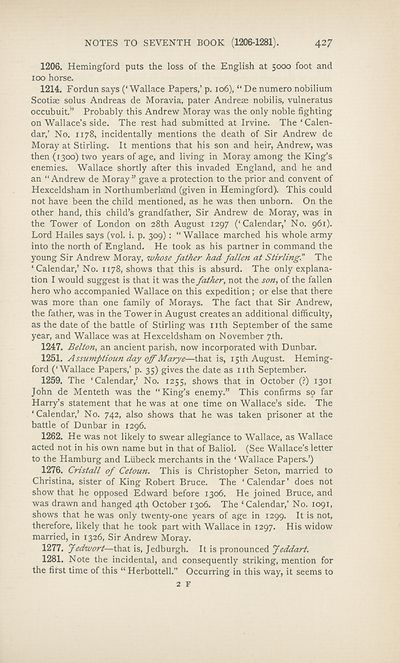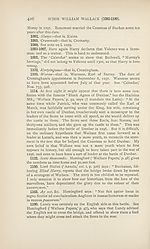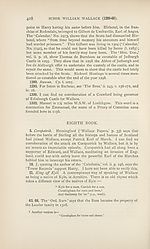Scottish Text Society publications > Old series > Actis and deidis of the illustere and vailzeand campioun, Schir William Wallace, Knicht of Ellerslie
(493) Page 427
Download files
Complete book:
Individual page:
Thumbnail gallery: Grid view | List view

NOTES TO SEVENTH BOOK (1206-1281). 427
1206. Hemingford puts the loss of the English at 5000 foot and
too horse.
1214. Fordun says (‘Wallace Papers,’ p. 106), “ De numero nobilium
Scotiae solus Andreas de Moravia, pater Andreas nobilis, vulneratus
occubuit.” Probably this Andrew Moray was the only noble fighting
on Wallace’s side. The rest had submitted at Irvine. The ‘Calen¬
dar,’ No. 1x78, incidentally mentions the death of Sir Andrew de
Moray at Stirling. It mentions that his son and heir, Andrew, was
then (1300) two years of age, and living in Moray among the King’s
enemies. Wallace shortly after this invaded England, and he and
an “Andrew de Moray” gave a protection to the prior and convent of
Hexceldsham in Northumberland (given in Hemingford). This could
not have been the child mentioned, as he was then unborn. On the
other hand, this child’s grandfather, Sir Andrew de Moray, was in
the Tower of London on 28th August 1297 (‘Calendar,’ No. 961).
Lord Hailes says (vol. i. p. 309) : “Wallace marched his whole army
into the north of England. He took as his partner in command the
young Sir Andrew Moray, whose father had fallen at Stirling!' The
‘Calendar,’ No. 1178, shows that this is absurd. The only explana¬
tion I would suggest is that it was the father, not the son, of the fallen
hero who accompanied Wallace on this expedition ; or else that there
was more than one family of Morays. The fact that Sir Andrew,
the father, was in the Tower in August creates an additional difficulty,
as the date of the battle of Stirling was nth September of the same
year, and Wallace was at Hexceldsham on November 7th.
1247. Belton, an ancient parish, now incorporated with Dunbar.
1251. Assumptioun day off Marye—that is, 15th August. Heming¬
ford (‘Wallace Papers,’ p. 35) gives the date as 11th September.
1259. The ‘Calendar,’ No. 1255, shows that in October (?) 1301
John de Menteth was the “King’s enemy.” This confirms sp far
Harry’s statement that he was at one time on Wallace’s side. The
‘Calendar,’ No. 742, also shows that he was taken prisoner at the
battle of Dunbar in 1296.
1262. He was not likely to swear allegiance to Wallace, as Wallace
acted not in his own name but in that of Baliol. (See Wallace’s letter
to the Hamburg and Liibeck merchants in the ‘Wallace Papers.’)
1276. Cristall of Cetoun. This is Christopher Seton, married to
Christina, sister of King Robert Bruce. The ‘Calendar’ does not
show that he opposed Edward before 1306. He joined Bruce, and
was drawn and hanged 4th October 1306. The ‘Calendar,’ No. 1091,
shows that he was only twenty-one years of age in 1299. It is not,
therefore, likely that he took part with Wallace in 1297. His widow
married, in 1326, Sir Andrew Moray.
1277. Jedwort—that is, Jedburgh. It is pronounced
1281. Note the incidental, and consequently striking, mention for
the first time of this “ Herbottell.” Occurring in this way, it seems to
2 F
1206. Hemingford puts the loss of the English at 5000 foot and
too horse.
1214. Fordun says (‘Wallace Papers,’ p. 106), “ De numero nobilium
Scotiae solus Andreas de Moravia, pater Andreas nobilis, vulneratus
occubuit.” Probably this Andrew Moray was the only noble fighting
on Wallace’s side. The rest had submitted at Irvine. The ‘Calen¬
dar,’ No. 1x78, incidentally mentions the death of Sir Andrew de
Moray at Stirling. It mentions that his son and heir, Andrew, was
then (1300) two years of age, and living in Moray among the King’s
enemies. Wallace shortly after this invaded England, and he and
an “Andrew de Moray” gave a protection to the prior and convent of
Hexceldsham in Northumberland (given in Hemingford). This could
not have been the child mentioned, as he was then unborn. On the
other hand, this child’s grandfather, Sir Andrew de Moray, was in
the Tower of London on 28th August 1297 (‘Calendar,’ No. 961).
Lord Hailes says (vol. i. p. 309) : “Wallace marched his whole army
into the north of England. He took as his partner in command the
young Sir Andrew Moray, whose father had fallen at Stirling!' The
‘Calendar,’ No. 1178, shows that this is absurd. The only explana¬
tion I would suggest is that it was the father, not the son, of the fallen
hero who accompanied Wallace on this expedition ; or else that there
was more than one family of Morays. The fact that Sir Andrew,
the father, was in the Tower in August creates an additional difficulty,
as the date of the battle of Stirling was nth September of the same
year, and Wallace was at Hexceldsham on November 7th.
1247. Belton, an ancient parish, now incorporated with Dunbar.
1251. Assumptioun day off Marye—that is, 15th August. Heming¬
ford (‘Wallace Papers,’ p. 35) gives the date as 11th September.
1259. The ‘Calendar,’ No. 1255, shows that in October (?) 1301
John de Menteth was the “King’s enemy.” This confirms sp far
Harry’s statement that he was at one time on Wallace’s side. The
‘Calendar,’ No. 742, also shows that he was taken prisoner at the
battle of Dunbar in 1296.
1262. He was not likely to swear allegiance to Wallace, as Wallace
acted not in his own name but in that of Baliol. (See Wallace’s letter
to the Hamburg and Liibeck merchants in the ‘Wallace Papers.’)
1276. Cristall of Cetoun. This is Christopher Seton, married to
Christina, sister of King Robert Bruce. The ‘Calendar’ does not
show that he opposed Edward before 1306. He joined Bruce, and
was drawn and hanged 4th October 1306. The ‘Calendar,’ No. 1091,
shows that he was only twenty-one years of age in 1299. It is not,
therefore, likely that he took part with Wallace in 1297. His widow
married, in 1326, Sir Andrew Moray.
1277. Jedwort—that is, Jedburgh. It is pronounced
1281. Note the incidental, and consequently striking, mention for
the first time of this “ Herbottell.” Occurring in this way, it seems to
2 F
Set display mode to: Large image | Zoom image | Transcription
Images and transcriptions on this page, including medium image downloads, may be used under the Creative Commons Attribution 4.0 International Licence unless otherwise stated. ![]()
| Permanent URL | https://digital.nls.uk/107006455 |
|---|
| Description | A collection of over 100 Scottish texts dating from around 1400 to 1700. Most titles are in Scots, and include editions of poetry, drama, and prose by major Scottish writers such as John Barbour, William Dunbar, Gavin Douglas, and George Buchanan. Edited by a key scholarly publisher of Scotland's literary history, and published from the late 19th century onwards by the Scottish Text Society. Available here are STS series 1-3. |
|---|

